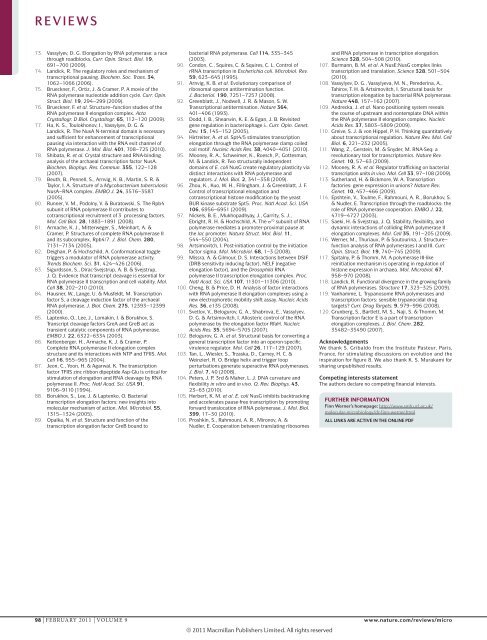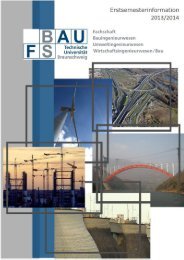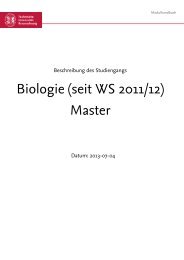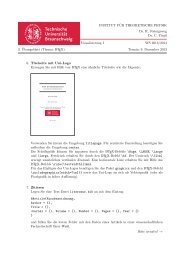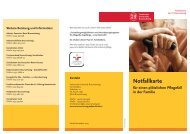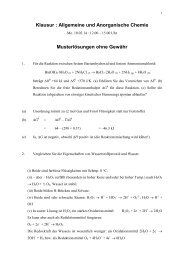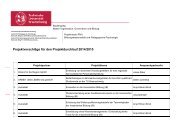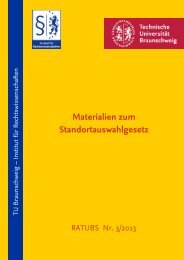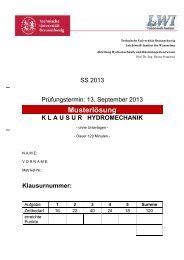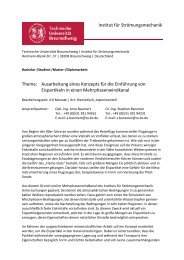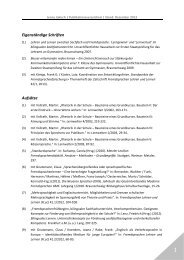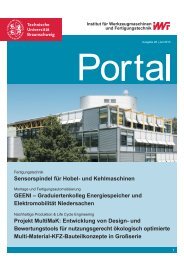L - Technische Universität Braunschweig
L - Technische Universität Braunschweig
L - Technische Universität Braunschweig
You also want an ePaper? Increase the reach of your titles
YUMPU automatically turns print PDFs into web optimized ePapers that Google loves.
REVIEWS<br />
73. Vassylyev, D. G. Elongation by RNA polymerase: a race<br />
through roadblocks. Curr. Opin. Struct. Biol. 19,<br />
691–700 (2009).<br />
74. Landick, R. The regulatory roles and mechanism of<br />
transcriptional pausing. Biochem. Soc. Trans. 34,<br />
1062–1066 (2006).<br />
75. Brueckner, F., Ortiz, J. & Cramer, P. A movie of the<br />
RNA polymerase nucleotide addition cycle. Curr. Opin.<br />
Struct. Biol. 19, 294–299 (2009).<br />
76. Brueckner, F. et al. Structure–function studies of the<br />
RNA polymerase II elongation complex. Acta<br />
Crystallogr. D Biol. Crystallogr. 65, 112–120 (2009).<br />
77. Ha, K. S., Toulokhonov, I., Vassylyev, D. G. &<br />
Landick, R. The NusA N‐terminal domain is necessary<br />
and sufficient for enhancement of transcriptional<br />
pausing via interaction with the RNA exit channel of<br />
RNA polymerase. J. Mol. Biol. 401, 708–725 (2010).<br />
78. Shibata, R. et al. Crystal structure and RNA-binding<br />
analysis of the archaeal transcription factor NusA.<br />
Biochem. Biophys. Res. Commun. 355, 122–128<br />
(2007).<br />
79. Beuth, B., Pennell, S., Arnvig, K. B., Martin, S. R. &<br />
Taylor, I. A. Structure of a Mycobacterium tuberculosis<br />
NusA–RNA complex. EMBO J. 24, 3576–3587<br />
(2005).<br />
80. Runner, V. M., Podolny, V. & Buratowski, S. The Rpb4<br />
subunit of RNA polymerase II contributes to<br />
cotranscriptional recruitment of 3ʹ processing factors.<br />
Mol. Cell Biol. 28, 1883–1891 (2008).<br />
81. Armache, K. J., Mitterweger, S., Meinhart, A. &<br />
Cramer, P. Structures of complete RNA polymerase II<br />
and its subcomplex, Rpb4/7. J. Biol. Chem. 280,<br />
7131–7134 (2005).<br />
82. Deighan, P. & Hochschild, A. Conformational toggle<br />
triggers a modulator of RNA polymerase activity.<br />
Trends Biochem. Sci. 31, 424–426 (2006).<br />
83. Sigurdsson, S., Dirac-Svejstrup, A. B. & Svejstrup,<br />
J. Q. Evidence that transcript cleavage is essential for<br />
RNA polymerase II transcription and cell viability. Mol.<br />
Cell 38, 202–210 (2010).<br />
84. Hausner, W., Lange, U. & Musfeldt, M. Transcription<br />
factor S, a cleavage induction factor of the archaeal<br />
RNA polymerase. J. Biol. Chem. 275, 12393–12399<br />
(2000).<br />
85. Laptenko, O., Lee, J., Lomakin, I. & Borukhov, S.<br />
Transcript cleavage factors GreA and GreB act as<br />
transient catalytic components of RNA polymerase.<br />
EMBO J. 22, 6322–6334 (2003).<br />
86. Kettenberger, H., Armache, K. J. & Cramer, P.<br />
Complete RNA polymerase II elongation complex<br />
structure and its interactions with NTP and TFIIS. Mol.<br />
Cell 16, 955–965 (2004).<br />
87. Jeon, C., Yoon, H. & Agarwal, K. The transcription<br />
factor TFIIS zinc ribbon dipeptide Asp-Glu is critical for<br />
stimulation of elongation and RNA cleavage by RNA<br />
polymerase II. Proc. Natl Acad. Sci. USA 91,<br />
9106–9110 (1994).<br />
88. Borukhov, S., Lee, J. & Laptenko, O. Bacterial<br />
transcription elongation factors: new insights into<br />
molecular mechanism of action. Mol. Microbiol. 55,<br />
1315–1324 (2005).<br />
89. Opalka, N. et al. Structure and function of the<br />
transcription elongation factor GreB bound to<br />
bacterial RNA polymerase. Cell 114, 335–345<br />
(2003).<br />
90. Condon, C., Squires, C. & Squires, C. L. Control of<br />
rRNA transcription in Escherichia coli. Microbiol. Rev.<br />
59, 623–645 (1995).<br />
91. Arnvig, K. B. et al. Evolutionary comparison of<br />
ribosomal operon antitermination function.<br />
J. Bacteriol. 190, 7251–7257 (2008).<br />
92. Greenblatt, J., Nodwell, J. R. & Mason, S. W.<br />
Transcriptional antitermination. Nature 364,<br />
401–406 (1993).<br />
93. Dodd, I. B., Shearwin, K. E. & Egan, J. B. Revisited<br />
gene regulation in bacteriophage l. Curr. Opin. Genet.<br />
Dev. 15, 145–152 (2005).<br />
94. Hirtreiter, A. et al. Spt4/5 stimulates transcription<br />
elongation through the RNA polymerase clamp coiled<br />
coil motif. Nucleic Acids Res. 38, 4040–4051 (2010).<br />
95. Mooney, R. A., Schweimer, K., Roesch, P., Gottesman,<br />
M. & Landick, R. Two structurally independent<br />
domains of E. coli NusG create regulatory plasticity via<br />
distinct interactions with RNA polymerase and<br />
regulators. J. Mol. Biol. 2, 341–358 (2009).<br />
96. Zhou, K., Kuo, W. H., Fillingham, J. & Greenblatt, J. F.<br />
Control of transcriptional elongation and<br />
cotranscriptional histone modification by the yeast<br />
BUR kinase substrate Spt5. Proc. Natl Acad. Sci. USA<br />
106, 6956–6951 (2009).<br />
97. Nickels, B. E., Mukhopadhyay, J., Garrity, S. J.,<br />
Ebright, R. H. & Hochschild, A. The s 70 subunit of RNA<br />
polymerase mediates a promoter-proximal pause at<br />
the lac promoter. Nature Struct. Mol. Biol. 11,<br />
544–550 (2004).<br />
98. Artsimovitch, I. Post-initiation control by the initiation<br />
factor sigma. Mol. Microbiol. 68, 1–3 (2008).<br />
99. Missra, A. & Gilmour, D. S. Interactions between DSIF<br />
(DRB sensitivity inducing factor), NELF (negative<br />
elongation factor), and the Drosophila RNA<br />
polymerase II transcription elongation complex. Proc.<br />
Natl Acad. Sci. USA 107, 11301–11306 (2010).<br />
100. Cheng, B. & Price, D. H. Analysis of factor interactions<br />
with RNA polymerase II elongation complexes using a<br />
new electrophoretic mobility shift assay. Nucleic Acids<br />
Res. 36, e135 (2008).<br />
101. Svetlov, V., Belogurov, G. A., Shabrova, E., Vassylyev,<br />
D. G. & Artsimovitch, I. Allosteric control of the RNA<br />
polymerase by the elongation factor RfaH. Nucleic<br />
Acids Res. 35, 5694–5705 (2007).<br />
102. Belogurov, G. A. et al. Structural basis for converting a<br />
general transcription factor into an operon-specific<br />
virulence regulator. Mol. Cell 26, 117–129 (2007).<br />
103. Tan, L., Wiesler, S., Trzaska, D., Carney, H. C. &<br />
Weinzierl, R. O. Bridge helix and trigger loop<br />
perturbations generate superactive RNA polymerases.<br />
J. Biol. 7, 40 (2008).<br />
104. Peters, J. P. 3rd & Maher, L. J. DNA curvature and<br />
flexibility in vitro and in vivo. Q. Rev. Biophys. 43,<br />
23–63 (2010).<br />
105. Herbert, K. M. et al. E. coli NusG inhibits backtracking<br />
and accelerates pause-free transcription by promoting<br />
forward translocation of RNA polymerase. J. Mol. Biol.<br />
399, 17–30 (2010).<br />
106. Proshkin, S., Rahmouni, A. R., Mironov, A. &<br />
Nudler, E. Cooperation between translating ribosomes<br />
and RNA polymerase in transcription elongation.<br />
Science 328, 504–508 (2010).<br />
107. Burmann, B. M. et al. A NusE:NusG complex links<br />
transcription and translation. Science 328, 501–504<br />
(2010).<br />
108. Vassylyev, D. G., Vassylyeva, M. N., Perederina, A.,<br />
Tahirov, T. H. & Artsimovitch, I. Structural basis for<br />
transcription elongation by bacterial RNA polymerase.<br />
Nature 448, 157–162 (2007).<br />
109. Andrecka, J. et al. Nano positioning system reveals<br />
the course of upstream and nontemplate DNA within<br />
the RNA polymerase II elongation complex. Nucleic<br />
Acids Res. 37, 5803–5809 (2009).<br />
110. Greive, S. J. & von Hippel, P. H. Thinking quantitatively<br />
about transcriptional regulation. Nature Rev. Mol. Cell<br />
Biol. 6, 221–232 (2005).<br />
111. Wang, Z., Gerstein, M. & Snyder, M. RNA-Seq: a<br />
revolutionary tool for transcriptomics. Nature Rev.<br />
Genet. 10, 57–63 (2009).<br />
112. Mooney, R. A. et al. Regulator trafficking on bacterial<br />
transcription units in vivo. Mol. Cell 33, 97–108 (2009).<br />
113. Sutherland, H. & Bickmore, W. A. Transcription<br />
factories: gene expression in unions? Nature Rev.<br />
Genet. 10, 457–466 (2009).<br />
114. Epshtein, V., Toulme, F., Rahmouni, A. R., Borukhov, S.<br />
& Nudler, E. Transcription through the roadblocks: the<br />
role of RNA polymerase cooperation. EMBO J. 22,<br />
4719–4727 (2003).<br />
115. Saeki, H. & Svejstrup, J. Q. Stability, flexibility, and<br />
dynamic interactions of colliding RNA polymerase II<br />
elongation complexes. Mol. Cell 35, 191–205 (2009).<br />
116. Werner, M., Thuriaux, P. & Soutourina, J. Structure–<br />
function analysis of RNA polymerases I and III. Curr.<br />
Opin. Struct. Biol. 19, 740–745 (2009).<br />
117. Spitalny, P. & Thomm, M. A polymerase III-like<br />
reinitiation mechanism is operating in regulation of<br />
histone expression in archaea. Mol. Microbiol. 67,<br />
958–970 (2008).<br />
118. Landick, R. Functional divergence in the growing family<br />
of RNA polymerases. Structure 17, 323–325 (2009).<br />
119. Vanhamme, L. Trypanosome RNA polymerases and<br />
transcription factors: sensible trypanocidal drug<br />
targets? Curr. Drug Targets. 9, 979–996 (2008).<br />
120. Grunberg, S., Bartlett, M. S., Naji, S. & Thomm, M.<br />
Transcription factor E is a part of transcription<br />
elongation complexes. J. Biol. Chem. 282,<br />
35482–35490 (2007).<br />
Acknowledgements<br />
We thank S. Gribaldo from the Institute Pasteur, Paris,<br />
France, for stimulating discussions on evolution and the<br />
inspiration for figure 8. We also thank K. S. Murakami for<br />
sharing unpublished results.<br />
Competing interests statement<br />
The authors declare no competing financial interests.<br />
FURTHER INFORMATION<br />
Finn Werner’s homepage: http://www.smb.ucl.ac.uk/<br />
molecular-microbiology/dr-finn-werner.html<br />
All links are active in the online pdf<br />
98 | february 2011 | Volume 9 www.nature.com/reviews/micro<br />
© 2011 Macmillan Publishers Limited. All rights reserved


